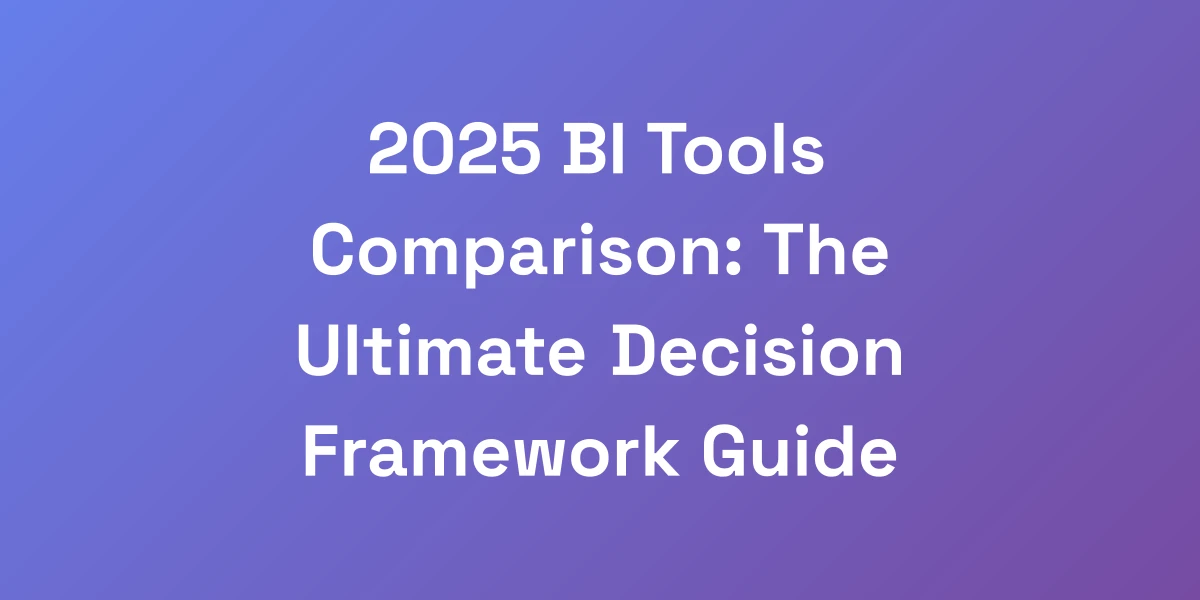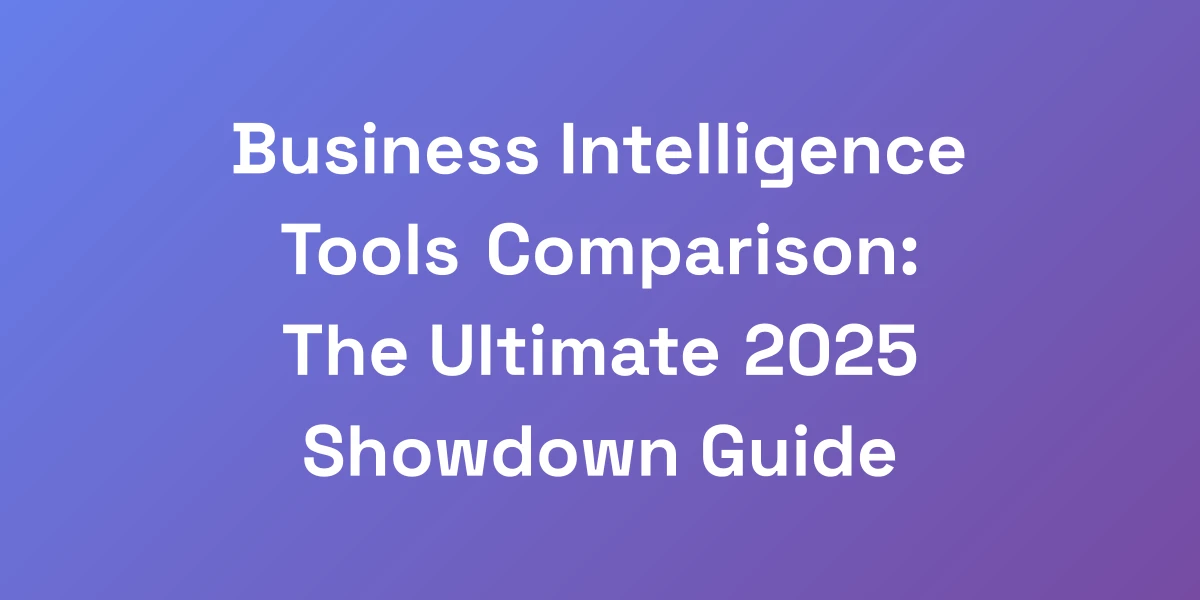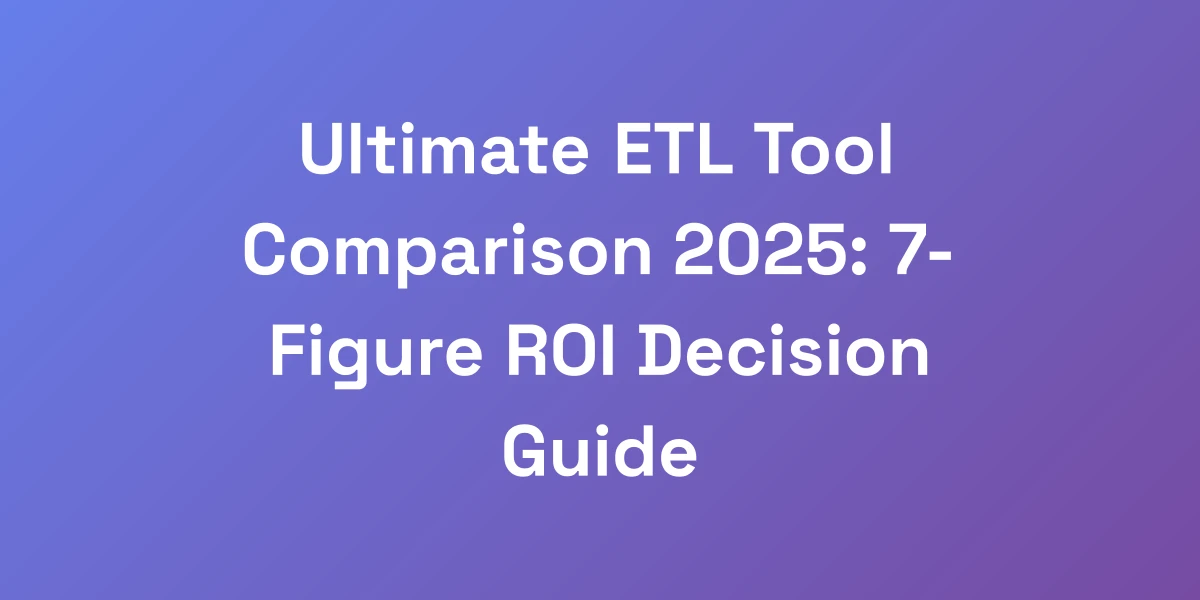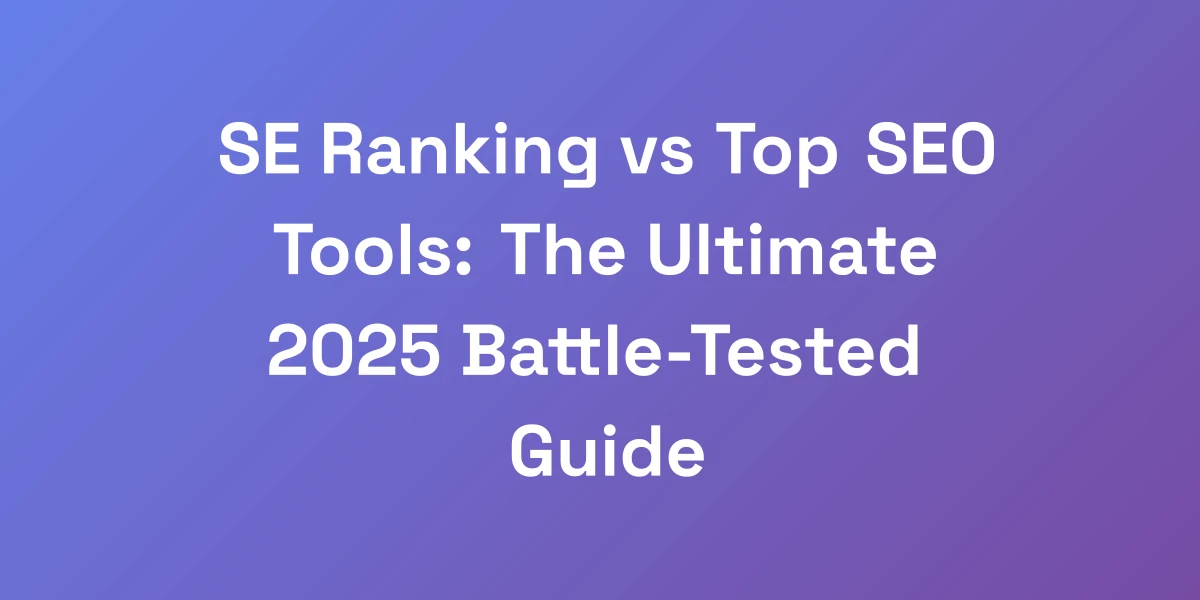
2025 BI Tools Comparison: The Ultimate Decision Framework Guide
Mar 14, 2025 | By [email protected]
Why Most Companies Fail at Choosing the Right BI Tool (And How to Avoid It)
Let me hit you with some truth: 90% of companies choose the wrong BI tool because they’re looking at flashy features instead of actual business impact. We’ve spent millions consulting with businesses, and here’s what we’ve learned: the right BI tool isn’t about having the most features—it’s about having the right features that drive revenue.
In today’s data-driven world, making the wrong choice can cost you more than just money—it can derail your entire strategy.
The Business Intelligence Software Market is rapidly growing and evolving, making the selection process even more critical.
So, how do you ensure you’re not part of that statistic? In this guide, we’re going to show you exactly how to evaluate BI tools like a CEO, not just an analyst. We’re talking about frameworks that will save you hundreds of thousands in wrong decisions.
The Real Cost of Choosing the Wrong BI Tool
Choosing the wrong BI tool isn’t just a minor hiccup—it can have severe financial repercussions. Imagine investing thousands in software that doesn’t integrate well with your existing systems or fails to provide actionable insights. The real cost includes not only the initial investment but also the opportunity cost of missed opportunities and lost revenue.
For instance, a mid-sized retail company implemented a BI tool that promised advanced analytics but ended up being too complex for their team. The result? Extended training periods, frustrated employees, and ultimately, a tool that was barely used. This led to wasted resources and a significant delay in achieving their business objectives. Check out these business intelligence examples to understand the impact of proper tool selection.
Moreover, failed BI implementations can erode trust in data-driven initiatives within your organization, making it harder to get buy-in for future projects.
Common Selection Mistakes That Drain Your ROI
One of the biggest mistakes companies make is focusing too much on the tool’s features rather than how those features align with their business needs. Another common error is underestimating the importance of user training and adoption. Without proper training, even the most advanced BI tools can become underutilized or misused.
- Feature Overload: Getting overwhelmed by a tool that has too many unnecessary features can complicate processes and reduce productivity.
- Ignoring Integration: Failing to consider how well the BI tool integrates with your existing systems can lead to data silos and inefficiencies.
- Underestimating Training Needs: Skimping on training can result in poor adoption rates and ineffective use of the tool.
- Cost Mismanagement: Not fully understanding the pricing models and long-term costs can drain your budget.
To avoid these pitfalls, use a structured evaluation framework that prioritizes your core business needs over flashy features. Consider using a BI tools comparison matrix to objectively evaluate your options.
The Strategic Advantage Framework
Our Strategic Advantage Framework is designed to help you evaluate SaaS business intelligence tools based on their potential to enhance your business operations and drive revenue. This framework focuses on four key areas:
- Business Alignment: Ensure the BI tool aligns with your strategic goals and business processes.
- User Accessibility: The tool should be user-friendly and accessible to all relevant stakeholders.
- Integration Capability: Seamless integration with your existing systems is crucial for data consistency and operational efficiency.
- Scalability: The tool should be able to grow with your business, handling increased data volumes and user demands.
By focusing on these areas, you can ensure your BI tool not only meets your current needs but also supports your future growth.
Quick Assessment Checklist
Use this checklist to quickly assess whether a BI tool is right for your business:
- Does it align with your business objectives?
- Is it user-friendly and accessible to your team?
- Can it integrate seamlessly with your existing systems?
- Is it scalable to accommodate future growth?
- What is the total cost of ownership, including licensing, training, and maintenance?
- Does it offer robust security features to protect your data?
Answering these questions will help you filter out tools that don’t meet your essential criteria, saving you time and resources in the long run.
Red Flags to Watch For
When evaluating BI tools, be on the lookout for these red flags:
- Lack of Customization: If a tool doesn’t allow you to customize dashboards and reports to your specific needs, it might not be the right fit.
- Poor Integration: Tools that struggle to integrate with your existing systems can create data silos and inefficiencies.
- Hidden Costs: Beware of pricing models that seem too good to be true—they often come with hidden fees for essential features or support.
- Limited Scalability: If a tool can’t grow with your business, you’ll likely need to switch solutions down the road, incurring additional costs.
- Weak Customer Support: Reliable customer support is crucial for resolving issues quickly and ensuring smooth operations.
Identifying these red flags early can prevent costly mistakes and ensure you choose a BI tool that truly supports your business goals.
The Core Four: Leading BI Tools Head-to-Head
Listen up, because this is where most comparisons get it wrong. Instead of giving you a watered-down feature list, we’re going to break down exactly how each tool impacts your bottom line. Power BI, Tableau, Looker, and Sisense—these aren’t just tools, they’re profit multipliers when used correctly. Refer to the Gartner Magic Quadrant for BI analytics for an in-depth analysis.
We’ll show you the hidden strengths and limitations that other comparisons won’t tell you about, and exactly which type of business each tool is perfect for.
Power BI: Microsoft’s Ecosystem Advantage
Power BI excels in integration with the Microsoft ecosystem. If your organization heavily relies on Microsoft products like Office 365, Azure, or Dynamics 365, Power BI is a natural fit. It offers robust data modeling and visualization capabilities at a competitive price.
Advantages:
- Seamless integration with Microsoft products
- Affordable pricing starting at $9.99/user/month
- Strong community and support resources
Limitations:
- Can become complex with large datasets
- Limited customization compared to Tableau
Real-world example: Toyota integrated Power BI to enhance supply chain visibility, reducing delays by 15% and improving on-time delivery metrics.
Actionable Tip: If your business is already using Microsoft products, leverage Power BI to maximize ROI through seamless integration and cost-effectiveness.
Tableau: Visualization Powerhouse
Tableau is renowned for its powerful data visualization capabilities. It allows users to create intricate and interactive dashboards with ease. While it’s more expensive, especially for large deployments, its intuitive interface makes it a favorite among data analysts and business intelligence professionals.
Advantages:
- Advanced and customizable visualizations
- Highly intuitive drag-and-drop interface
- Strong analytical capabilities
Limitations:
- Higher cost can be a barrier for smaller companies
- Steeper learning curve for non-technical users
Real-world example: A financial services firm used Tableau to create real-time dashboards, leading to a 20% increase in decision-making speed.
Actionable Tip: Invest in Tableau if your priority is top-tier data visualization and you have the budget to leverage its full potential.
Looker: Data Modeling Excellence
Looker stands out with its exceptional data modeling capabilities. It’s built on LookML, a powerful modeling language that allows for precise data definitions and transformations. This makes Looker ideal for organizations that require granular data control and complex data relationships.
Advantages:
- Advanced data modeling with LookML
- Strong integration with Google Cloud services
- Scalable for large enterprises
Limitations:
- High cost, starting around $60,000 per year
- Requires technical expertise for LookML
Real-world example: A global manufacturing company implemented Looker to unify data across multiple regions, resulting in a 25% improvement in data accuracy and reporting.
Actionable Tip: Choose Looker if your business requires sophisticated data modeling and you have the technical expertise to fully utilize its capabilities.
Sisense: AI-Driven Analytics
Sisense leverages AI to provide powerful analytics capabilities. Its unique in-chip technology allows for handling large and complex datasets with ease. Sisense is suitable for enterprises that need robust, AI-driven insights without compromising on performance.
Advantages:
- AI-driven analytics and predictive capabilities
- Handles large and complex datasets efficiently
- Customizable and scalable
Limitations:
- Custom pricing starting at around $40,000 per year
- Implementation can be time-consuming
Real-world example: FM Logistics integrated Sisense with Azure, resulting in 80% faster data consolidation and a 15% cost reduction in operations.
Actionable Tip: Opt for Sisense if your organization deals with vast amounts of data and can benefit from AI-driven insights and scalability.
Performance Benchmarks
Performance is a critical factor when choosing a BI tool. Power BI and Sisense are known for their speed and efficiency in handling large datasets, while Tableau excels in rendering complex visualizations without lag. Looker’s performance is highly dependent on its integration with Google Cloud, offering robust speed and reliability in cloud environments. For insights on the best business intelligence (BI) software in 2025, check Infomineo’s latest analysis.
Consider running performance tests tailored to your specific data and use cases to determine which tool meets your speed and efficiency requirements.
Cost-to-Value Analysis
Analyzing the cost versus the value each BI tool provides is essential for making an informed decision:
- Power BI: Affordable pricing with strong integration capabilities, offering high value for Microsoft-centric organizations.
- Tableau: Higher costs are justified by superior visualization features and ease of use for data analysts.
- Looker: Significant investment required, but the advanced data modeling and scalability offer substantial value for large enterprises.
- Sisense: High initial costs are offset by AI-driven analytics and robust performance, delivering excellent value for data-intensive businesses.
Actionable Tip: Conduct a detailed cost-to-value analysis considering both immediate and long-term benefits to ensure you’re making a financially sound decision.
Integration Capabilities That Actually Matter
Here’s the thing about integrations: it’s not about how many you have, it’s about how effectively they amplify your existing tech stack. We’ve seen companies waste millions on tools that don’t play nice with their current systems. Incorporating reliable solutions like SQL compare tools can significantly enhance your data management and synchronization processes.
We’re going to dive deep into the real-world integration scenarios that make or break your BI implementation. This isn’t theory—it’s battle-tested experience from implementing these tools across different industries.
Essential Enterprise System Integrations
Successful BI implementations require seamless integration with your core enterprise systems, such as ERP, CRM, and marketing platforms. Power BI, for example, integrates effortlessly with Microsoft Dynamics 365, enabling unified data from sales, finance, and operations.
Actionable Tip: Identify your key enterprise systems and prioritize BI tools that offer out-of-the-box integrations with those systems to ensure data consistency and reduce implementation time.
Data Source Compatibility Matrix
Ensure that the BI tool supports all your data sources, whether on-premises or in the cloud. Tableau and Looker offer extensive compatibility with a wide range of data sources, including SQL databases, cloud storage, and APIs.
Example: Spear Education connected its call center software with its BI solution, improving agent efficiency and saving 35 hours of rep time per week.
Actionable Tip: Create a list of all your data sources and verify that the BI tool you’re considering can connect to each one without requiring extensive custom development.
API Flexibility and Custom Development
APIs play a crucial role in extending the functionality of BI tools. Tools like Sisense offer robust API capabilities, allowing for custom dashboard creation and integration with other applications. Power BI also provides extensive API support, enabling custom data connectors and automations.
Actionable Tip: Evaluate the API capabilities of each BI tool to ensure you can customize and extend the tool’s functionality to meet your specific business needs.
Security and Compliance Standards
Data security and compliance are non-negotiable. Power BI complies with GDPR and HIPAA, making it suitable for industries with strict data privacy requirements. Similarly, Looker adheres to PCI-DSS standards, essential for financial institutions handling sensitive transactions.
Actionable Tip: Ensure that the BI tool meets your industry’s compliance standards and offers robust security features, such as data encryption, user authentication, and role-based access controls.
Scalability Factors
As your business grows, your BI needs will evolve. Sisense is known for its scalability, handling large datasets effortlessly, while Tableau and Power BI also offer scalable solutions to accommodate growing data volumes and user bases.
Actionable Tip: Choose a BI tool that can scale with your business, ensuring it can handle increasing data volumes and an expanding number of users without compromising performance.
Implementation Timeline Reality Check
Implementation timelines can vary significantly between BI tools. Power BI is generally quicker to deploy, especially for companies already using Microsoft products. Tableau and Looker might require more time due to their advanced customization and data modeling features.
Actionable Tip: Plan your implementation timeline realistically, accounting for the complexity of your data, the level of customization required, and the availability of skilled personnel to manage the deployment.
The Decision Matrix: Matching Tools to Business Cases
Stop trying to force-fit a BI tool into your business. Instead, let’s align your specific use cases with the right tool. Incorporating specialized solutions like online SQL comparison tools can provide significant advantages in specific scenarios.
We’re going to give you our proprietary decision matrix that we use with our consulting clients. This isn’t just another comparison chart—it’s a strategic framework that considers your growth trajectory, team capabilities, and future scaling needs. This is the exact process we use to make multi-million dollar decisions.
Industry-Specific Requirements
Different industries have unique BI needs. For example, healthcare organizations require tools with strong compliance features, while manufacturing companies may prioritize supply chain analytics. Power BI’s integration with Microsoft products benefits many sectors, whereas Looker’s data modeling excellence is ideal for finance and technology industries. Additionally, niche sectors like short-term rentals can leverage SEO for Airbnb to enhance their data strategies.
Actionable Tip: Identify the specific BI requirements of your industry and choose a tool that caters specifically to those needs to maximize relevance and effectiveness.
Company Size and Growth Stage Alignment
Startups and small businesses may prefer cost-effective and easy-to-implement tools like Power BI or Amazon Quicksight, while large enterprises might benefit from the advanced features and scalability of Looker or Sisense.
Actionable Tip: Match the BI tool to your company’s size and growth stage, ensuring it can support your current operations and future expansion without requiring a tool switch down the line.
Technical Expertise Requirements
Assess your team’s technical capabilities. Tableau and Looker require a higher level of technical expertise for optimal use, whereas Power BI is more accessible to non-technical users. Sisense offers flexibility but may require dedicated IT support for custom integrations. To build a proficient team, learn how to become a business intelligence analyst.
Actionable Tip: Choose a BI tool that aligns with your team’s technical skills or consider investing in training to bridge any gaps, ensuring smooth adoption and effective use of the tool.
Budget Optimization Strategies
Understanding the total cost of ownership, including licensing, implementation, training, and maintenance, is crucial. Power BI offers competitive pricing, making it a good option for budget-conscious organizations, while Looker and Sisense, though pricier, provide extensive features that might justify the higher investment for larger enterprises. Similarly, integrating price comparison software can optimize your pricing strategies and enhance profitability.
Actionable Tip: Develop a comprehensive budget that includes all potential costs and weigh them against the expected benefits to ensure you’re making a financially sound decision.
ROI Calculation Framework
Calculate the potential ROI by considering both direct and indirect benefits. Direct benefits include cost savings and revenue growth from improved decision-making. Indirect benefits might involve increased employee productivity and enhanced data-driven culture.
For example, Coca-Cola European Partners achieved a 10% reduction in logistics costs using Power BI, demonstrating significant ROI from their BI investment.
Actionable Tip: Use our ROI Calculation Framework to quantify the financial benefits of each BI tool option, helping you prioritize tools that offer the highest return on investment.
Future-Proofing Factors
Ensure that the BI tool you choose is adaptable to future technological advancements and business needs. Look for tools that regularly update their features, support emerging technologies like AI and machine learning, and offer flexible integration options.
Actionable Tip: Select a BI tool that is not only effective today but also versatile enough to adapt to future trends and evolving business requirements, safeguarding your investment long-term.
Implementation and Optimization Playbook
Let’s get tactical. We’re going to show you exactly how to implement your chosen BI tool for maximum impact. This isn’t just about installation—it’s about creating a system that drives decisions and generates revenue. We’ll cover the specific steps and strategies that separate successful implementations from expensive failures. This is the same playbook we use with our seven-figure clients.
30-60-90 Day Implementation Plan
A structured implementation plan is crucial for a successful BI tool deployment. Here’s a streamlined approach:
- First 30 Days: Define objectives, assemble your implementation team, and set up the initial configuration. Focus on integrating core data sources and establishing data governance policies.
- Next 60 Days: Develop initial dashboards and reports, conduct user training sessions, and gather feedback to refine the setup. Start onboarding key users and encourage them to explore the tool.
- Final 90 Days: Optimize performance, scale up data integrations, and roll out advanced features. Monitor usage patterns, address any issues, and ensure continuous improvement through regular reviews.
Actionable Tip: Follow this phased approach to ensure a smooth implementation, allowing time for adjustment and optimization at each stage.
Team Training and Adoption Strategies
The success of your BI tool hinges on user adoption. Invest in comprehensive training programs tailored to different user roles, from data analysts to executives. Encourage a culture of data-driven decision-making by showcasing the tool’s benefits through real-life use cases and success stories.
Actionable Tip: Develop a training schedule that includes hands-on workshops, online tutorials, and continuous support resources to ensure all users are comfortable and proficient with the BI tool.
Performance Optimization Techniques
To maximize the efficiency and effectiveness of your BI tool, regularly monitor and optimize its performance. This includes fine-tuning data queries, optimizing dashboard load times, and ensuring data refresh rates meet your business needs.
Actionable Tip: Implement regular performance audits and use optimization techniques such as indexing, caching, and query optimization to maintain high performance as your data scales.
Common Pitfalls and Solutions
Even with the best planning, challenges can arise during implementation. Common pitfalls include inadequate data quality, resistance to change, and insufficient support. Address these by enforcing strict data governance, fostering open communication, and providing ongoing support and resources.
Real-world example: A financial services firm struggled with data inconsistency during their Tableau implementation. By establishing rigorous data governance and providing targeted training, they overcame these challenges and achieved a 20% increase in decision-making speed.
Actionable Tip: Anticipate potential challenges and develop proactive strategies to address them, ensuring a smoother implementation process.
Measuring Implementation Success
Define clear metrics to evaluate the success of your BI implementation. Common success indicators include user adoption rates, the accuracy and timeliness of reports, and the overall impact on business decision-making and revenue growth.
Actionable Tip: Establish baseline metrics before implementation and regularly compare them against post-implementation performance to gauge success and identify areas for improvement.
Scaling Your BI Infrastructure
As your business grows, so will your data needs. Ensure your BI infrastructure is scalable to handle increasing data volumes, more complex analyses, and a growing number of users. This might involve upgrading your hardware, expanding your storage solutions, or migrating to more robust cloud platforms.
Actionable Tip: Plan for scalability from the outset by choosing a BI tool that can grow with your business and by implementing scalable data architecture to support future expansion.
Conclusion
Choosing the right BI tool is a critical decision that can significantly impact your business’s success. By understanding the common pitfalls, leveraging our Strategic Advantage Framework, and following a structured implementation plan, you can avoid the costly mistakes that lead to failed BI projects.
Remember, a BI tool is not just a software investment—it’s a strategic asset that can drive revenue, enhance operational efficiency, and empower your team to make data-driven decisions.
Ready to make an informed decision on your BI tool? Start by assessing your business needs with our Quick Assessment Checklist and watch your data strategy transform from a challenge into a powerful growth engine.
We’d love to hear about your experiences with BI tools. What challenges have you faced, and how did you overcome them? Drop your thoughts in the comments below and let’s continue the conversation.
![DiffChecker Online: The Ultimate Guide to Text Comparison Tools [2025]](https://autoseo.eazyseo.co/wp-content/uploads/2025/03/DiffChecker-Online-The-Ultimate-Guide-to-Text-Com.webp)







